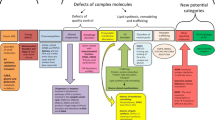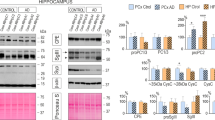Abstract
In a few rare diseases, specialised studies in cerebrospinal fluid (CSF) are required to identify the underlying metabolic disorder. We aimed to explore the possibility of detecting key synaptic proteins in the CSF, in particular dopaminergic and gabaergic, as new procedures that could be useful for both pathophysiological and diagnostic purposes in investigation of inherited disorders of neurotransmission. Dopamine receptor type 2 (D2R), dopamine transporter (DAT) and vesicular monoamine transporter type 2 (VMAT2) were analysed in CSF samples from 30 healthy controls (11 days to 17 years) by western blot analysis. Because VMAT2 was the only protein with intracellular localisation, and in order to compare results, GABA vesicular transporter, which is another intracellular protein, was also studied. Spearman’s correlation and Student’s t tests were applied to compare optical density signals between different proteins. All these synaptic proteins could be easily detected and quantified in the CSF. DAT, D2R and GABA VT expression decrease with age, particularly in the first months of life, reflecting the expected intense synaptic activity and neuronal circuitry formation. A statistically significant relationship was found between D2R and DAT expression, reinforcing the previous evidence of DAT regulation by D2R. To our knowledge, there are no previous studies on human CSF reporting a reliable analysis of these proteins. These kinds of studies could help elucidate new causes of disturbed dopaminergic and gabaergic transmission as well as understanding different responses to L-dopa in inherited disorders affecting dopamine metabolism. Moreover, this approach to synaptic activity in vivo can be extended to different groups of proteins and diseases.



Similar content being viewed by others
References
Biou D, Benoist JF, Nguyen-Thi Xuan Huong C, Morel P, Marchand M (2000) Cerebrospinal fluid protein concentrations in children: age-related values in patients without disorders of the central nervous system. Clin Chem 2000 46(3):399–403
Bolan EA, Kivell B, Jaligam V et al (2007) D2 receptors regulate dopamine transporter function via an extracellular signal-regulated kinases 1 and 2-dependent and phosphoinositide 3 kinase-independent mechanism. Mol Pharmacol 71(5):1222–1232
Cartier EA, Parra LA, Baust TB et al (2010) A biochemical and functional protein complex involving dopamine synthesis and transport into synaptic vesicles. J Biol Chem 285(3):1957–1966
Corradini I, Verderio C, Sala M et al (2009) SNAP-25 in neuropsychiatric disorders. Ann NY Acad Sci 1152:93–99
De Mei C, Ramos M, Iitaka C et al (2009) Getting specialized: presynaptic and postsynaptic dopamine D2 receptors. Curr Opin Pharmacol 9(1):53–58
Egaña LA, Cuevas RA, Baust TB et al (2009) Physical and functional interaction between the dopamine transporter and the synaptic vesicle protein synaptogyrin-3. J Neurosci 29(14):4592–4604
Eriksen J, Jørgensen TN, Gether U (2010) Regulation of dopamine transporter function by protein-protein interactions: new discoveries and methodological challenges. J Neurochem 113(1):27–41
García-Cazorla A, Serrano M, Pérez-Dueñas B et al (2007) Secondary abnormalities of neurotransmitters in infants with neurological disorders. Dev Med Child Neurol 49:740–744
García-Cazorla A, Duarte S, Serrano M (2008) Mitochondrial diseases mimicking neurotransmitter defects. Mitochondrion 8(3):273–278
García-Cazorla A, Wolf NI, Hoffmann GF (2010) Neurological disease. In: Hoffmann GF et al (eds) Inherited metabolic diseases: a clinical approach. Springer, Berlin, pp 127–159
Glickstein SB, Schmauss C (2001) Dopamine receptor functions: lessons from knockout mice [corrected]. Pharmacol Ther 91(1):63–83
Harrington MG, Fonteh AN, Oborina E et al (2009) The morphology and biochemistry of nanostructures provide evidence for synthesis and signaling functions in human cerebrospinal fluid. Cerebrospinal Fluid Res 6:10
Kauer JA, Malenka RC (2007) Synaptic plasticity and addiction. Nat Rev Neurosci 8(11):844–858
Marín-Valencia I, Serrano M, Ormazabal A et al (2008) Biochemical diagnosis of dopaminergic disturbances in paediatric patients: analysis of cerebrospinal fluid homovanillic acid and other biogenic amines. Clin Biochem 41(16–17):1306–1315
Ormazabal A, García-Cazorla A, Fernández Y et al (2005) HPLC with electrochemical and fluorescence detection procedures for the diagnosis of inborn errors of biogenic amines and pterins. J Neurosci Methods 142(1):153–158
Rustom A, Saffrich R, Markovic I et al (2004) Nanotubular highways for intercellular organelle transport. Science 303(5660):1007–1010
Serrano M, Pérez-Dueñas B, Ormazábal A et al (2008) Levodopa therapy in a Lesch-Nyhan disease patient: pathological, biochemical, neuroimaging, and therapeutic remarks. Mov Disord 23(9):1297–1300
Sorra KE, Mishra A, Kirov SA, Harris KM (2006) Dense core vesicles resemble active-zone transport vesicles and are diminished following synaptogenesis in mature hippocampal slices. Neuroscience 141(4):2097–2106
Südhof TC (2008) Neuroligins and neurexins link synaptic function to cognitive disease. Nature 455(7215):903–911
Südhof TC, Malenka RC (2008) Understanding synapses: past, present, and future. Neuron 60(3):469–476
Thouvenot E, Urbach S, Dantec C et al (2008) Enhanced detection of CNS cell secretome in plasma protein-depleted cerebrospinal fluid. J Proteome Res 7(10):4409–4421
Van Der Heyden JC, Rotteveel JJ, Wevers RA (2003) Eur J Paediatr Neurol 7(1):31–37
Volz TJ, Hanson GR, Fleckenstein AE (2006) Kinetic analysis of developmental changes in vesicular monoamine transporter-2 function. Synapse 60(6):474–477
Volz TJ, Farnsworth SJ, Rowley SD (2009) Age-dependent differences in dopamine transporter and vesicular monoamine transporter-2 function and their implications for methamphetamine neurotoxicity. Synapse 63(2):147–151
Willemsen MA, Verbeek MM, Kamsteeg EJ et al (2010) Tyrosine hydroxylase deficiency: a treatable disorder of brain catecholamine biosynthesis. Brain 133(6):1810–1822
Witzmann FA, Arnold RJ, Bai F et al (2005) A proteomic survey of rat cerebral cortical synaptosomes. Proteomics 5(8):2177–2201
Zougman A, Pilch B, Podtelejnikov A et al (2008) Integrated analysis of the cerebrospinal fluid peptidome and proteome. J Proteome Res 7(1):386–399
Acknowledgements
We greatly appreciate the technical assistance of Nuria Valmanzo and Belén Ramos (Mental Health laboratory, Fundació Sant Joan de Déu, Barcelona). Statistical studies were done with the collaboration of Raquel Iniesta (Fundació Sant Joan de Déu, Barcelona). CIBERER is an initiative of the ISCIII (MICINN, Spain). This study was funded by the grant FIS PS09/01132. C.O. is supported by a grant from Caja Navarra.
Author information
Authors and Affiliations
Corresponding author
Additional information
Communicated by: Sedel Frederic
Competing interests: None declared.
Rights and permissions
About this article
Cite this article
Duarte, S.T., Ortez, C., Pérez, A. et al. Analysis of synaptic proteins in the cerebrospinal fluid as a new tool in the study of inborn errors of neurotransmission. J Inherit Metab Dis 34, 523–528 (2011). https://doi.org/10.1007/s10545-010-9256-6
Received:
Revised:
Accepted:
Published:
Issue Date:
DOI: https://doi.org/10.1007/s10545-010-9256-6




